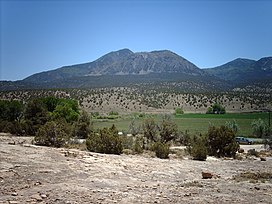
Back جبل ات ARZ Ute Peak (bukid sa Tinipong Bansa, Montezuma County) CEB Ute Peak Czech Ute Mountain LLD Dził Naajiní NV Montanha Ute Portuguese یوٹ ماؤنٹین Urdu
| Ute Peak | |
|---|---|
| Ute Mountain | |
 Ute Peak from the north. | |
| Highest point | |
| Elevation | 9,984 ft (3,043 m)[1][2] |
| Prominence | 4,039 ft (1,231 m)[3] |
| Isolation | 34.27 mi (55.15 km)[3] |
| Listing | Colorado prominent summits Colorado range high points |
| Coordinates | 37°17′03″N 108°46′43″W / 37.284083°N 108.7786626°W[1] |
| Geography | |
| Location | Ute Mountain Ute Tribe Reservation, Montezuma County, Colorado, United States[4] |
| Parent range | Ute Mountains[3] |
| Topo map | USGS 7.5' topographic map Battle Rock, Colorado[1] |
Ute Mountain, also known as Ute Peak or Sleeping Ute Mountain (/ˈjuːt/; Ute: Wisuv Káruv, Navajo: Dził Naajiní), is a peak within the Ute Mountains, a small mountain range in the southwestern corner of Colorado. It is on the northern edge of the Ute Mountain Ute Tribe Reservation. The Reservation forms the southwestern corner of the state and of Montezuma County.
Nomenclature for this peak and its range varies. The highest peak is sometimes known as Sleeping Ute Mountain; the entire range is also identified as one large mountain, called Sleeping Ute Mountain,[5] on some maps;[6] and the range is sometimes called the Sleeping Ute Mountains. All of these forms of the mountain's name and of the range's name can be found on various USGS maps, databases and reports.
The Ute Mountains, with a collective profile commonly known as "The Sleeping Ute", are a dense cluster of peaks approximately 5 by 12 miles (8 by 19 km) in extent and stand in isolation from other mountains. Despite being much lower than Colorado's highest peaks, Ute Mountain is the eighth most topographically prominent peak in the state, due to this isolation. It is also notable for its large local relief in all directions, especially its rise of roughly 4,250 ft (1,295 m) over the Montezuma Valley to the southeast.
The Sleeping Ute is said to resemble a Ute chief lying on his back with arms folded across his chest. The mountains were valued as a sacred place by the Weeminuche Ute band. It is still a sacred place to their descendants, the Ute Mountain Ute Tribe, and still plays a role in their ceremonies as indicated by the "Sundance Ground" on some topographical maps nestled between The Knees and Horse Peak (ribcage).
Originally, the northern part of the mountains were outside the reservation boundaries as reduced following a series of treaties in the late 19th century, but a trade of land now in Mesa Verde National Park, approximately 15 miles (24 km) east, for federal land on the mountain, allowed the reservation boundary to be extended north to McElmo Creek and encompass the entire mountain range. In particular, this means that recreational access to the range by outsiders is severely restricted. Few roads or trails are found in the mountains, although radio towers and water tanks have been built, and a road along Cottonwood Wash from Towaoc nearly reaches the summit of Ute Peak.
- ^ a b c "UTE". NGS Data Sheet. National Geodetic Survey, National Oceanic and Atmospheric Administration, United States Department of Commerce. Retrieved October 29, 2014.
- ^ The elevation of Ute Peak includes an adjustment of +1.139 m (+3.74 ft) from NGVD 29 to NAVD 88.
- ^ a b c "Ute Peak, Colorado". Peakbagger.com. Retrieved October 29, 2014.
- ^ "Ute Peak". Geographic Names Information System. United States Geological Survey, United States Department of the Interior. Retrieved November 14, 2014.
- ^ "Ute Mountain". Geographic Names Information System. United States Geological Survey, United States Department of the Interior. Retrieved 2008-11-26.
- ^ "Ute Mountain". TopoQuest.com. Retrieved 2008-11-26.
